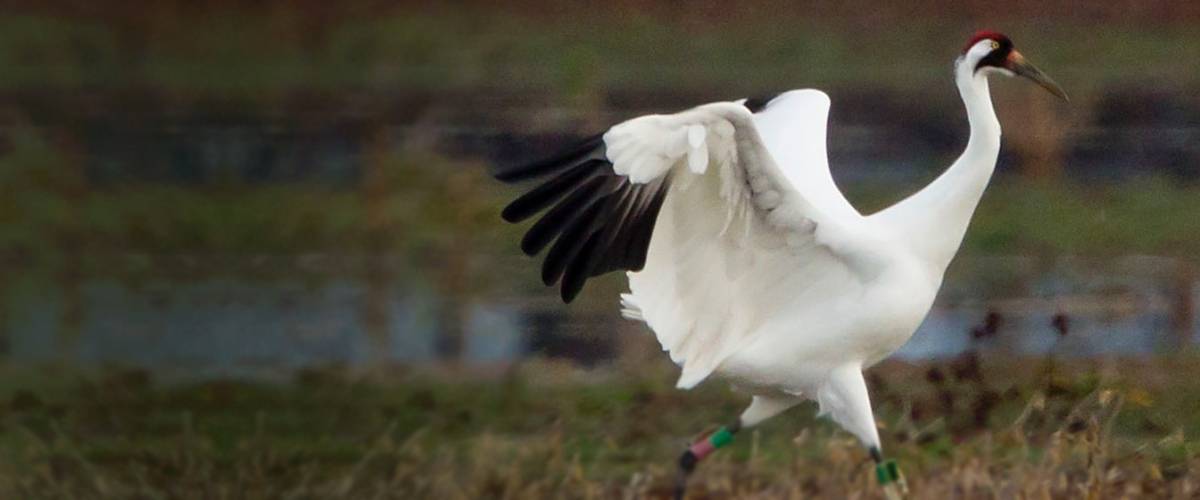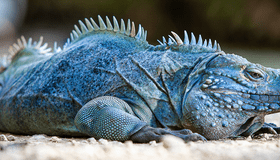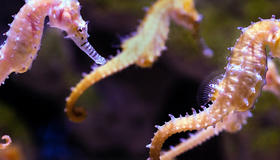
March 5, 2020 – Morris Animal Foundation-funded researcher Dr. Kevin Kohl at the University of Pittsburgh is partnering with the International Crane Foundation to determine why some endangered whooping cranes raised in captivity have specific health issues while others do not. Dr. Kohl believes part of this puzzle lies in differences in the chicks’ microbiomes, which in turn could be linked to different rearing practices used in their reintroduction program.
“We are seeing health issues in artificially raised whooping cranes (cranes reared by costume-clad human caretakers) that we don’t usually see in chicks raised by their natural parents,” said Dr. Kohl. “These include respiratory and skeletal problems that may be associated to what kinds of bacteria the chicks are exposed to that help shape their microbiome.”
The microbiome is a term for the community of bacteria, fungi and other microscopic entities that live in and on our bodies. This complex society of organisms has many health benefits, including helping animals digest food and training the immune system early in life to combat diseases and infections. But studies also show that a disturbed, or abnormal microbiome, can contribute to health problems.
That’s what Dr. Kohl believes may be happening with the whooping cranes housed at the International Crane Foundation’s Wisconsin facility. If this proves true, tweaking the microbiome of artificially raised chicks may help enhance the overall health of these animals and improve recovery efforts of this species in the wild.
Microbiome to the Rescue
In a 2016 published paper in Scientific Reports, researchers found distinct differences in gut microbiomes of artificially raised versus wild-reared chicks in endangered red-crowned cranes in China. Taking the lead from this finding, Dr. Kohl and his colleague Dr. Barry Hartup, Director of Conservation Medicine at the International Crane Foundation, want to know if these changes also can explain the health disparities they are seeing in the whooping crane captive rearing program.
“Both parent-reared and artificially raised whooping crane chicks are cared for at our Wisconsin facility,” said Dr. Hartup. “The birds share the same environment, including same land, vegetation, water and food, but there are key differences between the groups. Parent-reared chicks are more robust in health and behavior. We hope microbiome research may provide insight into what is going on and improve our conservation efforts.”
Dr. Kohl and his team are gathering microbiome profiles on the cranes housed at the Wisconsin facility. They also are looking at the feasibility of reprogramming the microbiome of artificially raised chicks through a process called fecal transplant. Fecal transplants act like a probiotic and, just like its name implies, involves transferring fecal material from one animal to another – in this case from adult whooping cranes to artificially raised chicks to mimic what happens naturally in the wild.
Fecal transplantation has been successfully done in many other species, including humans. Drs. Kohl and Hartup hope fecal transplantation will reduce or eliminate the incidence of respiratory and skeletal issues in the artificially raised chicks. This, in turn, may boast the success of the rearing program by producing more robust whooping cranes for release into the wild.
“So far, we have identified two healthy donor crane parents and performed fecal transplants in two chicks,” said Dr. Kohl. “The procedure went smoothly and both chicks did not exhibit any skeletal deformities. If we continue to find that fecal transplants are beneficial for the artificially raised chicks, we will add this practice to crane reproduction and conservation strategies.”
Why Some Chicks are Artificially Reared
“The problem with whooping crane recovery in the United States and Canada is that parent cranes can’t produce fast enough for conservation efforts,” said Dr. Hartup. “The female whooping crane usually lays two eggs and only successfully rears one chick. This low reproduction rate in the wild and in captivity makes it difficult to repopulate the species quickly.”
Dr. Hartup and his colleagues at the International Crane Foundation increase the number of birds for release by removing eggs from the nests of breeding cranes at their facility. This process prompts the female to lay another clutch of one or two eggs. The team usually takes four to six eggs a year from each fertile female whooping crane in their care, leaving one or two eggs for chicks to be hatched and raised by their parents.
The other eggs are artificially incubated, and the resulting chicks are raised as a group by costumed-clad caretakers. (Imprinting occurs when a young animal recognizes another species as its parent - the costumes help the chicks avoid imprinting on the caretakers.) This process helps add to the pool of birds that can be released each year to repopulate the species.
Quantity Versus Quality
“Quantity of birds matters in the race to save the whooping crane,” said Dr. Hartup. “But, so does the quality of the birds we release into the wild. Microbiome research may hold the key to helping the whooping crane flocks become self-sustaining so they can thrive in the wild without the extraordinary measures needed to help them survive today.”
So far, quantity – producing both parent-reared and artificially raised chicks – has helped the wildlife community establish two major free-ranging flocks of whooping cranes in the United States. The next step is to improve the quality and overall health of chicks. Dr. Kohl’s work may be the key to building a healthier, more robust whooping crane for the long-term survival of this endangered species.
Photo Credit: Allan Claybon




